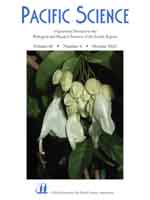Measurements of nectar volume and sugar concentration along two elevational gradients, in flower exclusion experiments, and over a diurnal cycle of nectar production were compared for invasive Lantana camara and endemic Lantana peduncularis in the Galápagos Islands during the dry season. Both species show the same pollination syndrome and are pollinated by Lepidoptera. Lantana camara flowers had a higher nectar volume than L. peduncularis flowers at every elevation and higher total sugar content. However, nectar in L. peduncularis flowers was much more concentrated than in L. camara flowers at lower elevations. The differences in nectar production between Lantana species seemed to be intrinsic and related to contrasting strategies to cope with drought. Nectar volume of unbagged flowers of L. camara was lower than that of bagged flowers at sunrise, which was probably related to consumption of nectar by nocturnal Lepidoptera. Nectar removal by floral visitors had a pronounced effect on total amount of nectar secreted by L. camara flowers but sugar concentration did not vary significantly. Our results suggest that L. camara may compete with L. peduncularis for pollinators.
How to translate text using browser tools
1 October 2012
Nectar Production by Invasive Lantana camara and Endemic L. peduncularis in the Galápagos Islands
J. Carrión-Tacuri,
R. Berjano,
G. Guerrero,
M. E. Figueroa,
A. Tye,
J. M. Castillo
ACCESS THE FULL ARTICLE

Pacific Science
Vol. 66 • No. 4
October 2012
Vol. 66 • No. 4
October 2012




